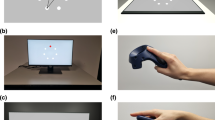Abstract
Transfer of training between real and virtual environments was examined using a pick-and-place task with two different difficulty levels. The task was to minimize the time to move cans from one color coded location in the first row to the same color coded location in the back row and then to reverse the process. In the first task, the front and back disk colors were aligned, and in the second disk order, the front and back disk colors were randomly placed on the table. Subjects trained in one environment were then tested in the other and their performance compared with that of subjects being trained in that environment. Some virtual world-trained subjects showed small but significant improvement in performance compared with the untrained subjects for the real world task for both disk arrangements. The differences in performance between the two groups decreased with trial number until no difference was seen at the end of the sessions. None of the real world-trained subjects showed any significant improvement when performing the task in the virtual world compared with the untrained subjects. These results suggest that transfer-of-training from virtual to real world tasks can take place under certain conditions.
Similar content being viewed by others
References
Bishop, G., W. Bricken, F. Brooks, M. Brown, C. Burbeck, N. Durlach, S. Ellis, H. Fuchs, M. Green, J. Lackner, M. McNeill, M. Moshell, R. Pausch, W. Robinett, M. Srinivasan, I. Sutherland, R. Urban, and E. Wenzel. Research directions in virtual environments.Computer Graphics 26N3:153–177, 1992.
Bos, P. J. Performance limits of stereoscopic viewing systems using active and passive glasses. Proc. of the IEEE Annual Virtual Reality Int. Symposium (VRAIS), Seattle, WA, Sept. 18–21, 1993, pp. 371–376.
Cruz-Neira, C., D. J. Sandin, and T. A. Defanti. Surroundscreen projection based virtual reality: the design and implementation of the CAVE.Computer Graphics 27:135–142, 1993.
Ghazisaedy, M., D. Adamczyk, D. J. Sandin, R. V. Kenyon, and T. A. Defanti. Ultrasonic calibration of a magnetic tracker in a virtual reality space. Proc. of the IEEE Annual Virtual Reality Int. Symposium (VRAIS), Raleigh, NC, Sept. 1995, pp. 179–188.
Held, R., and A. Hein. Adaptation to disarranged hand-eye coordination contingent upon re-afferent stimulation.Percept. Motor Skills 8:87–90, 1958.
Ishii, M., and M. Sato. A 3D interface device with force feedback: a virtual work space for pick-and-place tasks. Proc. of the IEEE Annual Virtual Reality Int. Symposium, Seattle, WA, Sept. 18–21, 1993, pp. 331–335.
Kozak, J. J., P. A. Hancock, E. J. Arthur, and S. T. Chrysler. Transfer of training from virtual reality.Ergon 36:777–784, 1993.
Montgomory, D. C., and E. A. Peck.Introduction to Linear Regression Analysis. New York: Wiley and Sons, 1982, pp. 109–180.
Ohzu, H. Artificial 3-D displays and visual functions.Vision Sci. Appl. (Conf. ed.) 2:48–51, 1994.
Rolfe, J. M., and K. J. Staples. Flight simulation. Cambridge, UK: Cambridge University Press, 1986, pp. 232–249.
Schachter, B. J. Computer image generation. New York: Wiley-Interscience, 1983, pp. 187–220.
Schmandt, C. Spatial input-display correspondence in a stereoscopic computer graphics workstation.Computer Graphics 17N3:253–259, 1983.
Welch, R. Prism adaptation: The “target-pointing effect” as a function of exposure trials. Percept. Psychophysiol. 9:102–104, 1971.
Welch, R. Adaptation of space perception. In:Handbook of Perception and Human Performance, vol 1., edited by K. Boff, L. Kaufman, and J. Thomas. New York: Wiley-Interscience, 1986, pp. 24-1–24-37.
Wickens, C. D., and P. Baker. Cognitive issues in virtual reality. In:Virtual Environments and Advanced Interface Design, edited by W. Barfield and T. Furness. New York: Oxford University Press, 1995, pp. 514–541.
Zhai, S., and P. Milgram. Human performance evaluation of manipulation schemes in virtual environments. Proc. of the IEEE Annual Virtual Reality Int. Symposium (VRAIS), Seattle, WA, Sept. 18–21, 1993, pp. 155–161.
Author information
Authors and Affiliations
Rights and permissions
About this article
Cite this article
Kenyon, R.V., Afenya, M.B. Training in virtual and real environments. Ann Biomed Eng 23, 445–455 (1995). https://doi.org/10.1007/BF02584444
Received:
Revised:
Accepted:
Issue Date:
DOI: https://doi.org/10.1007/BF02584444




